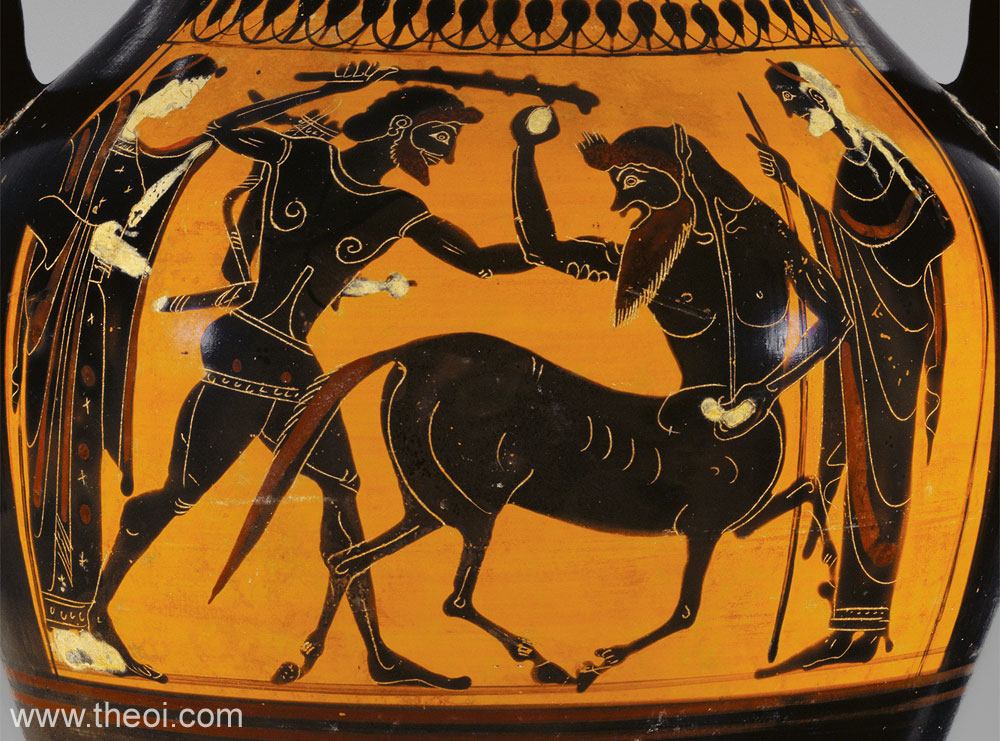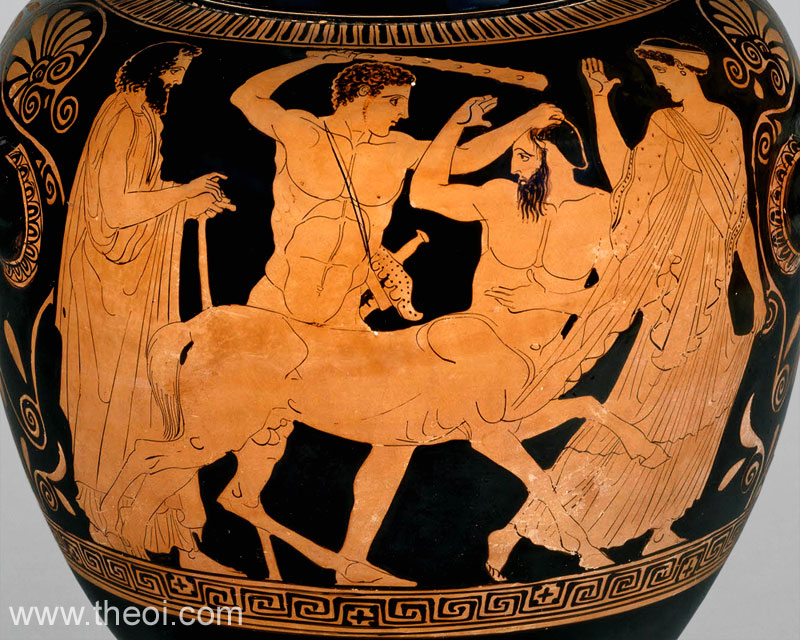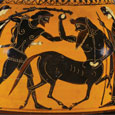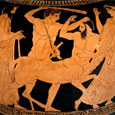EURYTION
Greek Name
Ευρυτιων
Transliteration
Eurytiôn
Latin Spelling
Eurytion
Translation
Fine-Flowing

EURYTION was a Peloponnesian Kentauros (Centaur) who forced King Dexamenos of Olenos to agree to let him marry his daughter Mnesimakhe. However when the centaur came to collect his bride, Herakles slew him.
Eurytion was the Peloponnesian version of the Thessalian centaur Eurytion who likewise attempted to steal a bride.
PARENTS
IXION & NEPHELE (Hyginus Fabulae 33)
ENCYCLOPEDIA
EURY′TION (Eurutiôn). A centaur who took to flight during the fight of Heracles with the centaurs; but he was afterwards killed by Heracles in the dominions of Dexamenus, whose daughter Eurytion was on the point of making his wife. (Apollod. ii. 5. § 4, &c.; comp. Diod. iv. 33; Hygin. Fab. 31.)
DEXA′MENUS (Dexamenos), a centaur who lived in Bura in Acolia, which town derived its name from his large stable for oxen. (Schol. ad Callim. Hymna. in Del. 102; Etymol. M. s. v.) According to others, he was a king of Olenus, and the father of Deïaneira, whom Heracles seduced during his stay with Dexamenus, who had hospitably received him. Heracles on parting promised to return and marry her. But in his absence the centaur Eurytion sued for Deïaneira's hand, and her father out of fear promised her to him. On the wedding day Heracles returned and slew Eurytion. (Hygin. Fab. 33.) Deïaneira is usually called a daughter of Oeneus, but Apollodorus (ii. 5. § 5) calls the daughter of Dexamenus, Mnesimache, and Diodorus (iv. 33) Hippolyte.
Source: Dictionary of Greek and Roman Biography and Mythology.
CLASSICAL LITERATURE QUOTES

Pseudo-Apollodorus, Bibliotheca 2. 83 - 87 (trans. Aldrich) (Greek mythographer C2nd A.D.) :
"Herakles (Heracles) asked for wine, but [the Kentauros (Centaur)] Pholos said that he was afraid to open the cask which was owned jointly be the Kentauroi (Centaurs). But Herakles told him not to worry, and opened the cask himself. Shortly thereafter, picking up the smell of the wine, the Kentauroi appeared at Pholos' cave, armed with rocks and clubs of silver fir. The first two who ventured in . . . Herakles turned back with a volley of fire-brands; he sent arrows after the others . . . The remaining Kentauroi fled this way and that, some to Mount Malea, Eurytion to Pholoe, Nessos to the Euenus river."
Pseudo-Apollodorus, Bibliotheca 2. 91 :
"Herakles made his way to the home of Dexamenos (Dexamenus) in Olenos (Olenus). He found his host about to be compelled to announce the engagement of his daughter Mnesimackhe (Mnesimache) to the Kentauros (Centaur) Eurytion. As Eurytion came to claim his bride, Dexamenos asked Herakles for help, and Herakles slew Eurytion."
Diodorus Siculus, Library of History 4. 33. 1 (trans. Oldfather) (Greek historian C1st B.C.) :
"[Herakles] returned to Olenos to Dexamenos. The latter's daughter Hippolyte was being joined in marriage to Azan, and when Herakles, as he sat at the wedding feast, observed the Kentauros (Centaur) Eurytion acting in an insulting manner towards Hippolyte and endeavoured to do violence to her, he slew him."
Pausanias, Description of Greece 7. 18. 1 (trans. Jones) (Greek travelogue C2nd A.D.) :
"Some forty stades from Dyme the river Peiros flows down into the sea; on the Peiros once stood the Akhaian (Achaean) city of Olenos. The poets who have sung of Herakles and his labours have found a favorite subject in Dexamenos, king of Olenos, and the entertainment Herakles received at his court. That Olenos was from the beginning a small town I find confirmed in an elegiac poem composed by Hermesianax [Greek elegiac poet C4th B.C.] about Eurytion the Kentauros (Centaur)."
Athenaeus, Deipnosophistae 1. 10e (trans. Gullick) (Greek rhetorician C2nd to C3rd A.D.) :
"By way of denouncing drunkenness the poet [Homer] portrays the Kyklops (Cyclops) [Polyphemos], for all his great size, as completely overcome, when drunk, by a small person; likewise the Kentauros (Centaur) Eurytion."
Pseudo-Hyginus, Fabulae 31 (trans. Grant) (Roman mythographer C2nd A.D.) :
"He [Herakles] killed Eurytion the Centaurus (Centaur) because he wooed Dejanira, daughter of Dexamenus, his hoped-for bride."
Pseudo-Hyginus, Fabulae 33 :
"When Hercules had come to the court of King Dexamenus and had violated his daughter Dejanira, promising he would marry her, Eurytion a Centaurus (Centaur), son of Ixion and Nubes [Nephele], after his departure sought Dejanira as a wife. Her father, fearing violence, promised her to him. On the appointed day he came with his brothers to the wedding. Hercules intervened, and killed the Centaur, and led home his betrothed."
ANCIENT GREEK ART
SOURCES
GREEK
- Apollodorus, The Library - Greek Mythography C2nd A.D.
- Diodorus Siculus, The Library of History - Greek History C1st B.C.
- Athenaeus, Deipnosophistae - Greek Rhetoric C3rd A.D.
ROMAN
- Hyginus, Fabulae - Latin Mythography C2nd A.D.
BIBLIOGRAPHY
A complete bibliography of the translations quoted on this page.

